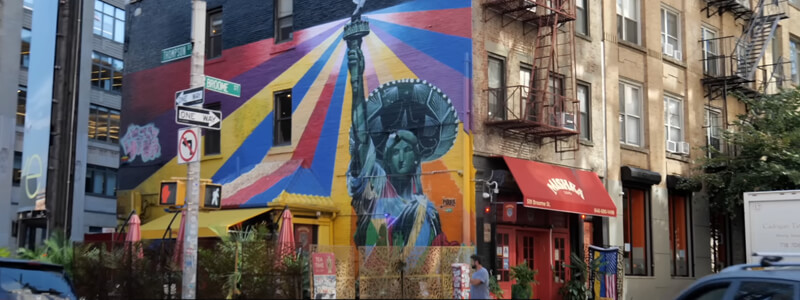Things to do in SoHo
Consisting of more than two dozen blocks in Lower Manhattan, SoHo (South of Houston Street) is a neighborhood that offers an exciting lifestyle. The scene in this district is dominated by historic cast-iron buildings that have been fully restored and preserved. Today, SoHo is lined with lofts, galleries, shops, eateries, and other establishments that epitomize a sophisticated urban enclave in the heart of The Big Apple. Click to book your SoHo, Little Italy, and Chinatown walking tour.
SoHo Attractions
The Cast Iron Historic District makes up a large portion of SoHo. As the name suggests, this historic section is lined with an array of buildings that have unique facades with cast iron. During the middle and late 19th centuries, this material was primarily used for industrial applications. However, SoHo became one of the city’s first neighborhoods to have residential buildings with iron elements rather than wood, stone, or bricks. As you walk the district, you’ll see hundreds of edifices with beautiful columns, arches, and other decorative carvings. Many of the cast iron buildings have been converted into studios, lofts, boutiques, cafes, and other types of mixed-used units.
Besides having some of the most beautiful ironworks in the world, SoHo boasts a vibrant nightlife scene that caters to local young professionals. Hip bars, chic lounges, and cool nightclubs are scattered in this diverse district that has undergone gentrification in the last few decades.
Perhaps the most notable cultural attraction in SoHo is the Drawing Center. Since opening in 1977, this museum has hosted hundreds of exhibits that celebrate virtually all forms of drawings. The Drawing Center usually hosts temporary and rotating exhibits through close ties with larger institutions, such as the Albright-Knox Museum and Tate Britain.
Due to its early roots in New York City’s industrial sectors, SoHo doesn’t have any major parks or green spaces. Nevertheless, SoHo Square is perhaps the only notable urban plaza in this bustling and densely developed neighborhood. This wedge-shaped public space includes a statue of General Jose Artigas, one of the earliest military leaders of Uruguay. This installation is actually a replica of an original statue that stands in the country’s capital city.
History of SoHo
In the middle and late 1800s, SoHo supported thriving retail and other commercial operations. Some of New York City’s finest department stores and high-end shops were located along bustling streets, such as Broadway. However, the local population was primarily dominated by working-class individuals in various crafts and skilled trades.
The cast iron industry in the United States significantly impacted the early development of SoHo. Hundreds of buildings were constructed with this unconventional material that was more durable and appealing than traditional masonry. Some of America’s best designers, architects, and construction companies were hired to erect stunning facades that resembled the classic beauty of European-style architecture. After World War II, SoHo has gradually transformed into a sophisticated district that caters to families as well as young professionals in the local financial sector.
SoHo Location and Transportation
Considered one of the busiest thoroughfares in Lower Manhattan, Houston Street defines the northern border of SoHo. Supporting traffic heading northbound, Crosby Street marks the eastern edge of the neighborhood. Stretching in a diagonal configuration, 6th Avenue runs along the western flank of the district. The southern tip of SoHo sits along Canal Street, which is heavily commercialized.
Situated underground, the Prince Street station is the only Subway stop in the district. You can take the N, Q, R, and W trains to this station that’s located at the corner of Broadway and Prince Street. These lines essentially connect SoHo with all of Midtown Manhattan and other subdivisions of the borough. Additionally, the Holland Tunnel leads directly to the border between SoHo and Tribeca.

